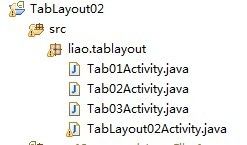Android_UI_实现TabHost的两种方法
实现TabHost有两种方式:
一、
1.不继承TabActivity
2.在布局文件中定义TabHost
1.图文解意:在布局文件tabhostdemo1.xml里怎么定义tabhost,大家看下面的图片(部分代码)即可,文章最后都会贴出完整代码
【注意】这里需要强调的是TabWidget的id必须是@android:id/tabs,FrameLayout的id必须是 @android:id/tabcontent。因为在android的api里这两个id都是定死的,必须用它定义好的,否则报错哦。
2.代码展示
1)TabHostdemo1Activity.java:
public class Tabhostdemo1Activity extends Activity {
/** Called when the activity is first created. */
@Override
public void onCreate(Bundle savedInstanceState) {
super.onCreate(savedInstanceState);
setContentView(R.layout.tabhostdemo1);
//获取tabhost
TabHost tabHost = (TabHost) this.findViewById(R.id.tabhost);
tabHost.setup();//实例化了tabWidget和tabContent
//第一个tab
TabSpec tabSpec01 = tabHost.newTabSpec("tab1"); //选项卡其实就是一个tabspec,获取一个新的TabHost.TabSpec,并关联到当前tabhost
tabSpec01.setIndicator("first tab", this.getResources().getDrawable(R.drawable.ic_launcher));//往选项卡里添加东西
tabSpec01.setContent(R.id.tab1_txt);
//第二个tab
TabSpec tabSpec02 = tabHost.newTabSpec("tab2");
tabSpec02.setIndicator("second tab", this.getResources().getDrawable(R.drawable.ic_launcher));
tabSpec02.setContent(R.id.tab2_txt);
//第三个tab
TabSpec tabSpec03 = tabHost.newTabSpec("tab3");
tabSpec03.setIndicator("third tab", this.getResources().getDrawable(R.drawable.ic_launcher));
tabSpec03.setContent(R.id.tab3_txt);
tabHost.addTab(tabSpec01);
tabHost.addTab(tabSpec02);
tabHost.addTab(tabSpec03);
}
}
步骤说明:
1>这个例子中我们从布局文件中获取到自定义的tabhost ,即TabHost tabHost = (TabHost) this.findViewById(R.id.tabHost); 使用setup()初始化,整个类继承的是Activity。
如果使用系统默认的tabhost,即(TabHost) this.findViewById(android.R.id.tabhost),红色部分就是系统自带的样式,直接用getTabhost()初始化,整个类继承TabActivity。
使用tabHost.setup();===>因为tabWidget和tabContent是在setUp()方法里初始化的,如果没有这句会报空指针异常。
2>TabSpec:理解tabspec,它就相当于一个tab选项卡,我们要给选项卡设置标签、添加图片和文字就用setIndicator(...)和setContent(...)。需要几个选项卡就创建几个tabspec。而tabhost就是一个盛装选项卡的容器,所以选项卡设置好后要把他们一 一添加到容器内,即tabHost.addTab(tabspec);
TabSpec tabSpec =tabHost.newTabSpec("tab"); TabSpec的构造函数是私有的,那TabHost必定要提供一个方法来创建TabSpec对象,这个方法就是newTabSpec(String tag)。
( "A tab(选项卡) has a tab indicator, content, and a tag that is used to keep track of it",TabHost.TabSpec就是管理这三个东西的——设置选项卡的标签和内容)
3>tabspec.setIndicator(...)——设置tab(选项卡)的标签label,它有三种形式如下,我们的例子用的是第三种
<1>setIndicator(CharSequence label)----指定一个label作为tab的指示器-----eg:setIndicator("first tab");这个first tab就是显示在选项卡上面的文字
<2>setIndicatior(View view)----指定一个view作为tab的指示器
<3>setIndicator(CharSequence label,Drawable icon)----指定一个label和icon作为tab的指示器-----eg:setIndicatior("tab",this.getResource().getDrawable(R.drawable.×××));
4>tabspec.setContent(...)——设置tab的内容content,它有三种形式,我们的例子用的是第一种
<1>setContent(int viewId)----是一个view 的id,这个view是用来创建tab内容的------eg:setContent(R.id.tab01_text);
<2>setContent(Intent intent)----指定一个intent,用来启动一个activity,来创建tab的content。想了解具体用法,请滚动到最后 (\0_</)!!!
<3>setContent(TabHost.TabContentFactory contentFactory)-----指定一个contentfactory来创建tab内容
5>最后不要忘了把你所创建的选项卡tab添加到tabhost容器里==>tabHost.addTab(tabspec01);
2)tabhostdemo1.xml
<?xml version="1.0" encoding="utf-8"?>
<LinearLayout xmlns:android="http://schemas.android.com/apk/res/android"
android:layout_width="match_parent"
android:layout_height="match_parent"
android:orientation="vertical" >
<TabHost
android:id="@+id/tabhost"
android:layout_width="fill_parent"
android:layout_height="fill_parent">
<LinearLayout
android:layout_width="fill_parent"
android:layout_height="fill_parent"
android:orientation="vertical">
<TabWidget
android:id="@android:id/tabs"
android:layout_width="fill_parent"
android:layout_height="wrap_content"/>
<FrameLayout
android:id="@android:id/tabcontent"
android:layout_width="fill_parent"
android:layout_height="fill_parent"
android:background="#505088">
<TextView
android:id="@+id/tab1_txt"
android:layout_width="fill_parent"
android:layout_height="fill_parent"
android:text="the content of tab1"
/>
<TextView
android:id="@+id/tab2_txt"
android:layout_width="fill_parent"
android:layout_height="fill_parent"
android:text="the content of tab2"/>
<TextView
android:id="@+id/tab3_txt"
android:layout_width="fill_parent"
android:layout_height="fill_parent"
android:text="the content of tab3"/>
</FrameLayout>
</LinearLayout>
</TabHost>
</LinearLayout>
二、
1.继承TabActivity
2.用getTabhost()方法获取TabHost
3.各tab内容在布局文件中定义
1.代码展示
1)TabHostdemo2Activity.java:
public class TabHostdemo2Activity extends TabActivity{
@Override
protected void onCreate(Bundle savedInstanceState) {
super.onCreate(savedInstanceState);
//我們繼承TabActivity,tabActivity裏面已經有一個TabHost對象,我們就直接通過getTabHost()獲取
TabHost tabHost = this.getTabHost();
//把自己的佈局文件添加到tabhost裏面,tabhost相當於一個viewroot
LayoutInflater.from(this).inflate(R.layout.tabhostdemo2, tabHost.getTabContentView(), true);
TabSpec tabSpec;
//第一个tab
tabSpec = tabHost.newTabSpec("tab1").setIndicator("first tab", this.getResources().getDrawable(R.drawable.ic_launcher))
.setContent(R.id.tab1_txt);
tabHost.addTab(tabSpec);
//第二个tab
tabSpec = tabHost.newTabSpec("tab2").setIndicator("second tab", this.getResources().getDrawable(R.drawable.ic_launcher))
.setContent(R.id.tab2_txt);
tabHost.addTab(tabSpec);
//第三个tab
tabSpec = tabHost.newTabSpec("tab3").setIndicator("third tab", this.getResources().getDrawable(R.drawable.ic_launcher))
.setContent(R.id.tab3_txt);
tabHost.addTab(tabSpec);
//設置第一次打開時默認顯示的tab,參數與tabHost.newTabSpec("tab1")的參數相同
tabHost.setCurrentTabByTag("tab2");
//設置第一次打開時默認顯示的tab,參數是其添加到標籤中的順序,tab的位置使從0開始的。
//tabHost.setCurrentTab(1);
}
}
步骤说明:
1>这种方法和第一种方法的区别只有两个地方 :
<1>用getTabhost()方法获取TabHost。因为我们继承了TabActivity,TabActivity里面已经有一个TabHost对象,我们直接通过getTabHost()方法获取。
<2>代码中我们不是用:setContentView(R.layout.tabhostdemo2);而是下面这句
LayoutInflater.from(this).inflate(R.layout.tabhostdemo2, tabHost.getTabContentView(), true);
inflate方法原型:public View inflate (XmlPullParser parser, ViewGroup root, boolean attachToRoot)
第一个参数是布局文件,第二个参数是根路径,第三个参数是是否添加到根路径,他们的关系是,如果attachToRoot为true那么我就把parser(这个内部是要解析的,我们不用考 虑)布局文件添加到根路径root下。getContentView()返回的是一个tabContent,类型为FrameLayout,所以我们是把布局文件添加到FrameLayout这个根目录下。
2>代码格式稍微变换了一下,但和第一种方法没差,这个例子我们只需要创建一个tabspec,但是创建完就要将其添加到tabHost中。
3>最后两句是设置第一次打开时默认显示哪一个选项卡tab,有两种方法,一个是根据参数相同,参数与tabHost.newTabSpec("tab1")中参数相同,一个是根据添加到TabHost容器里的顺序,注意的是,添加的顺序是从0开始的。
2)tabhostdemo2.xml
<?xml version="1.0" encoding="utf-8"?>
<FrameLayout xmlns:android="http://schemas.android.com/apk/res/android"
android:layout_width="match_parent"
android:layout_height="match_parent"
>
<LinearLayout
android:id="@+id/ly1"
android:layout_width="fill_parent"
android:layout_height="fill_parent">
<TextView
android:id="@+id/tab1_txt"
android:layout_width="fill_parent"
android:layout_height="fill_parent"
android:text="the content of tab1_txt"/>
</LinearLayout>
<LinearLayout
android:id="@+id/ly2"
android:layout_width="fill_parent"
android:layout_height="fill_parent">
<TextView
android:id="@+id/tab2_txt"
android:layout_width="fill_parent"
android:layout_height="fill_parent"
android:text="the content of tab2_txt"/>
</LinearLayout>
<LinearLayout
android:id="@+id/ly3"
android:layout_width="fill_parent"
android:layout_height="fill_parent">
<TextView
android:id="@+id/tab3_txt"
android:layout_width="fill_parent"
android:layout_height="fill_parent"
android:text="the content of tab03_txt"/>
</LinearLayout>
</FrameLayout>
注意根元素是FrameLayout
====================================================================================================================================
【Extera:setContent(Intent intent)怎么用---简单示例】
----指定一个intent,用来启动一个activity,来创建tab的content
直接贴代码了:
TabLayout02Activity.java
public class TabLayout02Activity extends TabActivity {
/** Called when the activity is first created. */
@Override
public void onCreate(Bundle savedInstanceState) {
super.onCreate(savedInstanceState);
setContentView(R.layout.main);
TabHost tabHost = getTabHost();//得到一个盛装tab的容器
Intent intent;
intent = new Intent().setClass(this, Tab01Activity.class);
tabHost.addTab(tabHost.newTabSpec("tab").setIndicator("first tab", getResources().getDrawable(R.drawable.icon)).setContent(intent));
intent = new Intent().setClass(this, Tab02Activity.class);
tabHost.addTab(tabHost.newTabSpec("tab2").setIndicator("second tab", getResources().getDrawable(R.drawable.icon)).setContent(intent));
intent = new Intent().setClass(this, Tab03Activity.class);
tabHost.addTab(tabHost.newTabSpec("tab3").setIndicator("third tab", getResources().getDrawable(R.drawable.icon)).setContent(intent));
}
}
提前建好三个Activity分别是Tab01Activity,Tab02Activity,Tab03Activity。

再来看Tab01Activity的代码:
Tab01Activity.java
public class Tab01Activity extends Activity{
@Override
protected void onCreate(Bundle savedInstanceState) {
// TODO Auto-generated method stub
super.onCreate(savedInstanceState);
TextView textview = new TextView(this);//创建一个新的文本组件
textview.setText("tag1");
setContentView(textview);
}
}
“A tab has a tab indicator,content,and a tag that is used to keep track of it”,TabHost.TabSpec就是管理这3个东西的(设置ab的标A tab h a tab indicator,content,and a tag that is used to keep track of it”,TabHost.TabSpec就是管理这3个东西的(设置tab的标签和内容):
A tab has a tab indicator,cotent,and a tag that is used to keep track of it”,TabHost.TabSpec就是管理这3个东西的(设置tab的标签和内
